|
|
Worcester Park 2008
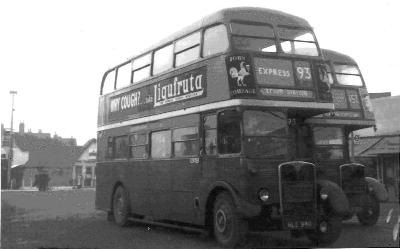 Route 93 Route 93
Route 93 is a well-known south London route, but when it
started ran almost entirely north of the river! After
serving destinations as diverse as Harrow Weald, Wembley,
Southall and Clapham Common, and featuring for a period a through
Sunday service between Southall and Cheam via Wembley, the
route settled down in the early days of the war to run between
Putney Bridge and Epsom, extended summer Sundays to Dorking.
The route was at least partly RT-operated from 1941
to 1976, although with gaps in the RT allocation in 1948 and 1950 -
does anyone know if this was a record?
The 93 Express was a
failed experiment and lasted less than 6 months. As a result,
it was not well photographed, and this is the only picture that we
have been able to trace. The photographer, the late Tony
Wright, lived on the 93 route where his father ran a photographic
business. Here, Sutton's RT4276 sits at Morden before setting
off to Epsom, no doubt to the disappointment of those wishing to
travel only as far as North Cheam.
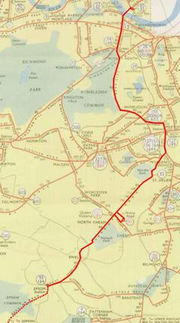 The blinds are blue,
and a slipboard carried the list of stops the bus would
serve. Photo © AM Wright, David
Ruddom collection
Route
PUTNEY HEATH or WIMBLEDON via Morden to NORTH CHEAM or
EPSOM
Timetable
The 93 (in conjunction with the 712) will
operate every 10-20 minutes between North Cheam and Morden,
less frequently on other sections. A limited Express service
will operate in the afternoon.
Timetable attached.
Road works at South Wimbledon may cause some disruption or
delay. Southbound services from Wimbledon will run via
Hartfield Road and will not serve The Broadway.
Main boarding points
Wimbledon Bus Station and stop D,
South Wimbledon stops SJ and SM,
Morden Station stops B and H,
North Cheam stops C and D,
Epsom Clock Tower.
Route
history
Started on 12 Apr 24 to serve an international football match
at Wembley, the 93 ran for one day only via Stonebridge Park,
Harlesden and Shepherds Bush to Putney High
Street. A week later it reappeared for the Easter
weekend, then running through to Wimbledon, becoming daily as far
as Putney the following Wednesday.
STL2483, working from Merton garage on a summer Sunday
in the late 1940s, pauses at North Cheam on its way to
Dorking. The bus was withdrawn in July 1950.
Photo © Derek Fisk,
Alan Cross collection
Over the following year, the northern terminus varied from Sudbury
and Stonebridge Park to Harrow Weald, and under the Bassom scheme,
the route number carried various suffixes. Summer
1926 saw a southward extension to Clapham Common on Sundays, but
this was a one-off and the following summer saw the extension to
Wimbledon instead.
Through these early years, the 93 was operated out of Putney
Bridge, Putney and Willesden garages, variously using K and NS
types.
May 1929 saw the section north of Craven Park transferred to
the 18 (80 years later worked by bendi-buses), with the 93 diverted
to terminate at Willesden.
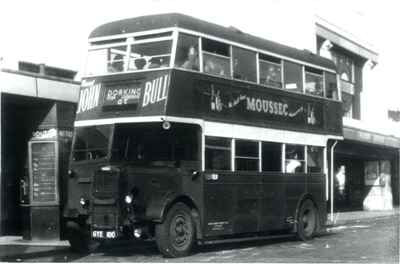 A year later, the southern end was extended to
Morden, bringing in operation by Sutton and Merton garages and
introducing a supplementary service (the 93 C) from
Putney Bridge Station to Morden Station, followed in the autumn by
a further extension to Cheam via North Cheam.
The summer Sunday extension
to Dorking was reintroduced after the war in 1946. The
following year, D95 is seen at Morden working a Dorking
service. The date is 12 October 1947, and the 'summer'
service will continue into November. At the time, Merton only
worked the route on Sundays. The bus is as delivered in brown
livery and it is hard to believe that the bus is five years newer
than Putney Bridge's RT2s.
Photo © Alan Cross
In May 1932, the northern terminus moved again, from Willseden
to Greenford Red Lion (where it met the new 211), then the route was extended again to
Southall White Swan that November. By this time the
route, still worked with NSs, was run from Putney Bridge, Sutton
and (on Sundays) Merton garages, with a peak requirement (on
Saturday) of 43 buses. Merton introduced LTs on its Sunday
allocation in 1933, followed by STLs in 1935, only to lose the
route a few months later.
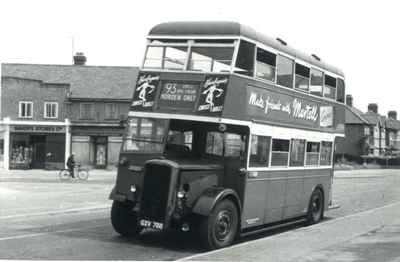
Southall to Cheam proved to be the
longest version of the route, with contraction starting in June
1934. First, the Cheam section was removed and the well-known
Priory Road terminus was introduced at North Cheam. In March
1936, the Southall to East Acton section was replaced by the 105,
then in October 1938 the East Acton to Hammersmith section was
replaced by the 72. At the same time, the route was extended
beyond North Cheam to Epsom, replacing the 70 from Morden. In
1936, the route became STL-operated again on Sundays, then
daily the following year.
First of a kind.
Merton's Brush-bodied
Daimler D57 stands at Priory Road, North Cheam on 24 Jun 51.
The bus displays an early use of the word 'ONLY' to qualify a
short-working destination, a practice not brought into general
usage until October of that year. Merton's Daimlers were
unusual in this respect as being virtually the only examples
of this usage on restricted blind displays.
Photo © Alan Cross
With the take-over of the 70 came
the summer Sunday operation to Dorking, which ran (with a gap
during the later war years from 1943 to 1945) through until 1960.
However, the war also saw the last contraction at the north end,
with the route terminating at Putney Bridge Station from October
1939.
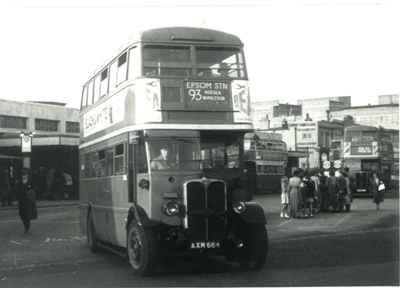 Putney Bridge (F) garage received its 2RT2s in 1941 and these
duly appeared on the 93 as well as the central London routes.
At the same time, Sutton's allocation switched from STL to a mix of
STL and ST.
After the first lowbridge Daimlers were delivered to Merton for the
127, all the subsequent highbridge
versions joined them, with the exception of the Romford Green
Lines, until the Park Royal-bodied batch in 1946. These were
a full 14'6" and too tall for Merton, so were sent to Sutton where
they took over all of Sutton's double-deck routes, including the
93, as delivered from April until November. The 93 used about
a quarter of the allocation of 100 buses.
'Leaning-back' STL410 leaves Morden for
Epsom on 16 Apr 52. Despite the dominance of
Daimlers at Sutton, the allocation was supplemented by STLs
from 1950 to 1952. This bus would however not last out the
year in passenger service, although it did perform training duties
before going for scrap at the start of 1954.
Photo © Alan Cross
From April 1947 and through until 1963, Merton (AL)
took back a part of the 93 operation, but only at
weekends. This was provided by Daimlers, with occasional
STLs, until the 3RTs arrived in 1953. Meanwhile, Sutton
(A) added some STLs to its D allocation from 1950 until it
received RTLs in January 1953.
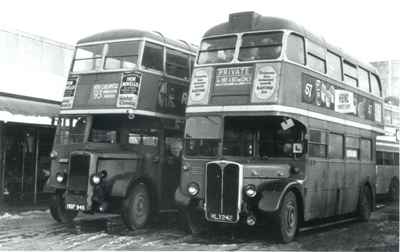
The RTLs remained only about a year, then A too
standardised on 3RTs. But this was a period when all manner
of buses were pressed into service, and the 93 saw a considerable
variety including loaned provincial buses.
This picture portrays a
moment in history. Sutton's Park Royal-bodied D269 on the
forecourt at Morden, whose driver is boarding for the next journey
to Nth. Cheam, goes about its normal business on the 93. But
next to it is trainer RT425 from Camberwell (Q), carrying a
load of staff in uniform. Correspondant Doug Ely (see note at
foot) suggests the reason. The date is Wednesday, 3 Jan 51,
at which time the only route worked by any garage other than
A/AL/AK to serve Morden was the 5A (Q and AL). The
following Monday 8/1/51, at the tram to bus conversion of Clapham
depot, tram 6 and bus 5A were withdrawn and replaced by
new route 189, worked from Clapham with new RTLs. So it would
seem likely that whilst the bus was from Q, the passengers are tram
drivers from CA learning the new route.
Photo © Alan Cross
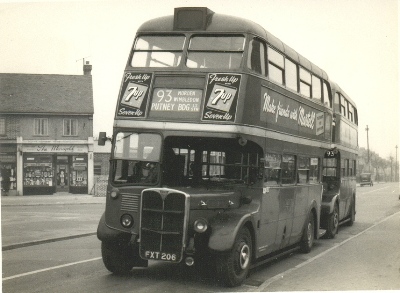
The last Daimlers were withdrawn by January 1954.
The 3RTs and RTLs then ran alongside F's 2RT2s until 1955 when
the 2RT2s were withdrawn from passenger service. Jim Andress
recalls hearing the 2RT2s' distinctive throbbing engine note as
they ran down the last few hundred yards of London Road (A24) from
the south into Morden Station. The sound seemed to echo back
from the white painted apartment blocks between the road and the
Underground sheds. The 2RT2s were replaced by RTLs.
Wartime and post-war RTs together on the
93. The Daimlers were gone by 1954, but the RT2s outlasted
them. Putney Bridge's RT31 stands at Priory Road, North
Cheam, with a canopy-blinded RT (or possibly RTL) behind.
Photo © Jim Andress
In 1955, LT experimented with five Express
routes, of different types and in different parts of
London. The 93 Express was introduced to speed up the journey
for passengers travelling beyond North Cheam, and ran in Monday to
Friday peak hours from 10 Oct 55. The service stopped
only at Sparrow Farm Road, Ewell Spring Hotel and Epsom
High Street and was an abject failure. Intermediate
passengers did not appreciate the reduction in the frequency of the
normal service and made their views known. The service ceased
on 31 Jan 56. The other services were more successful, and
the LT Traffic Committee were pleased with a success rate of 4
out of 5.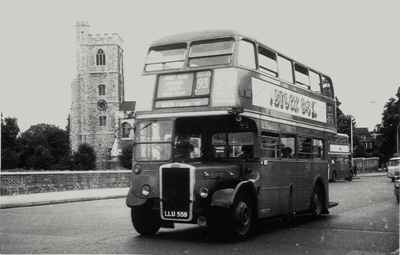
When Putney Bridge garage closed on 25 Nov 58, the allocation
moved to Chelverton Road (AF) on weekdays but was absorbed by A and
AL on Sundays, which therefore became an AEC-only day, the first
since the 2RT2s. This included the additonal summer
allocation for the Dorking extension, which continued for just two
more summers. AL's allocation moved to A in May
1963. Meanwhile, AF continued with its weekday allocation,
with Routemasters replacing the RTLs on Saturdays from
mid-1964 and RTs replacing the remainder 18 months later.
RTWs were never scheduled on
the 93, although they formed an important part of Putney Chelverton
Road's allocation until 1963, normally working the 22.
Nonetheless, RTW409 is properly blinded as it crosses Putney
Bridge, covering for an RTL.
Photo Alan Cross
collection
It was in February 1968 that the Epsom Station terminal working
was reversed, with buses facing north rather than south, but this
lasted only until 17 Apr 70 on the 93, as the route was cut back to
North Cheam and the Epsom section replaced by MB-operated 293
running along the same roads from Morden (Wimbledon in the
peaks). At the same time, Putney's allocation ceased, leaving
the route solely Sutton RT-operated for a short
while.
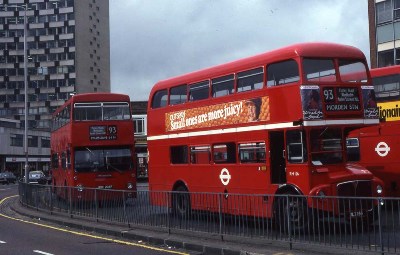 1973 saw Merton reintroduced to the route on Saturdays
only, with RTs from May, replaced by RMs from December.
Sutton in turn replaced the RTs by RMs on 27 Mar 76, and took sole
control of the route in October 1978, permanently (at least up
until now) this time. Daimlers (this time rear-engined)
replaced Routemasters progressively during 1981 and 1982,
officially completed by 4 Sep 82, and the inevitable OPO
conversion took place seven months later. Metrobuses took
over in 1991/2 and Olympians in turn in 1997/8. London
General now work the route with low-floor Volvos. 1973 saw Merton reintroduced to the route on Saturdays
only, with RTs from May, replaced by RMs from December.
Sutton in turn replaced the RTs by RMs on 27 Mar 76, and took sole
control of the route in October 1978, permanently (at least up
until now) this time. Daimlers (this time rear-engined)
replaced Routemasters progressively during 1981 and 1982,
officially completed by 4 Sep 82, and the inevitable OPO
conversion took place seven months later. Metrobuses took
over in 1991/2 and Olympians in turn in 1997/8. London
General now work the route with low-floor Volvos.
Morden Station on 15 Sep 81 during the period
of transition from Routemaster operation. Sutton's
early-bodied RM156 and D1238 lay-over on the forecourt. Note
the 'Pay Conductor' sign on the D - OMO conversion came on 23 Apr
83, prior to which the Daimlers worked with conductors.
Doug Ely writes in response to the photo (above) of trainer
RT425:
'The photo for RT425 is worthy of comment - the full load of
staff would probably indicate that the vehicle was being used as an
"official route learning bus". The procedure for learning new
routes varied between garages, but in my experience was a few
days of (a) an "official" bus driven by union men on stand down
from normal duties (in other words a good skive), followed by (b)
those that wished to do so riding on whatever service buses covered
the intending routing and gettng a "chit" signed to the effect they
had covered the route. The same agreed overtime was paid in
both cases. As a nominally allocated "L" bus the home
garage of RT425 may be misleading as to the staff who were on
board.'
Based on Doug's comments, we have pieced together the likely
story - see the photo caption above.
|
|